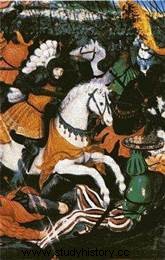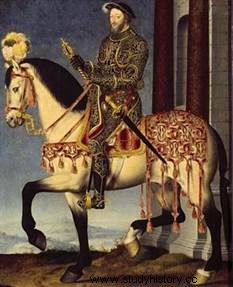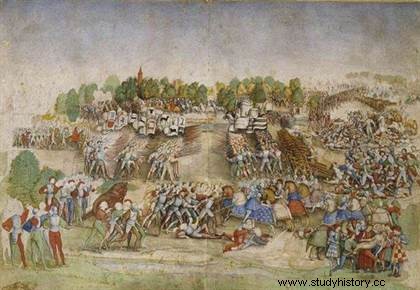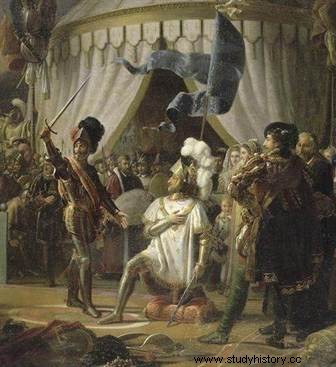 The Battle of Marignan is a famous victory won by Francis I on an army of Swiss mercenaries in the north of Italy, September 13 and 14, 1515. This military success will bring to the young king of France, dubbed knight on the battlefield by the lord of Bayard, a great popularity and a flattering reputation for bravery. 1515 is one of the dates most remembered by the French when we talk to them about history, sometimes adding Marignan. However, this battle deserves to be better known and put in its context, which is also too little known:the Italian wars. An epic that opened France to the wonders of Italy and the Renaissance.
The Battle of Marignan is a famous victory won by Francis I on an army of Swiss mercenaries in the north of Italy, September 13 and 14, 1515. This military success will bring to the young king of France, dubbed knight on the battlefield by the lord of Bayard, a great popularity and a flattering reputation for bravery. 1515 is one of the dates most remembered by the French when we talk to them about history, sometimes adding Marignan. However, this battle deserves to be better known and put in its context, which is also too little known:the Italian wars. An epic that opened France to the wonders of Italy and the Renaissance.
Marignan in the context of the Italian wars
Rich since the beginnings of the Renaissance, the Italian peninsula was coveted by European powers, in particular the sovereigns of France. Despite its financial power and its intellectual and artistic domination, the peninsula was then politically fragile, fragmented into rival principalities, the most important of which were the Papal States, the Kingdom of Naples, the Duchy of Milan and the Republics of Venice and Florence. Also, the Italian wars were the theater of territorial ambitions and the epicenter of tensions in Europe during the first half of the 16th century.
 Without going back to the dynasty of the Angevin kings of Naples, we can say that the wars of 'Italy involving France began with Charles VIII, himself short-lived king of Naples for a few months in 1495. It was above all with Louis XII that the kingdom of France began to really gain a foothold in Italy. From 1499, the king took Milan, then Genoa and in turn attacked the Regno in 1501. But if he managed to quickly dismiss Ludovico le More, he had to rely on important princes in the peninsula, such as César Borgia, but also the Pope and the Aragonese. For a few years, Louis XII manages to play alliances, relying on Florence and the Duchy of Milan, entering the fight against Venice. However, his influence begins to hinder the Italian princes, starting with Pope Julius II, who turns the alliances against France.
Without going back to the dynasty of the Angevin kings of Naples, we can say that the wars of 'Italy involving France began with Charles VIII, himself short-lived king of Naples for a few months in 1495. It was above all with Louis XII that the kingdom of France began to really gain a foothold in Italy. From 1499, the king took Milan, then Genoa and in turn attacked the Regno in 1501. But if he managed to quickly dismiss Ludovico le More, he had to rely on important princes in the peninsula, such as César Borgia, but also the Pope and the Aragonese. For a few years, Louis XII manages to play alliances, relying on Florence and the Duchy of Milan, entering the fight against Venice. However, his influence begins to hinder the Italian princes, starting with Pope Julius II, who turns the alliances against France.
A compromise was found in 1504:France abandoned Naples to the King of Aragon, but kept Milan. This solution is only temporary because Pope Julius II, who wants to assure his authority to all of Italy, sets up a new "Holy League" against France, including Venice, Aragon, Switzerland and England. Louis XII had to leave Italy in 1512, and suffered another setback the following year in Ravenna. The king's death in 1515 somewhat reassured the European courts, and in particular those of Italy, who looked favorably upon the young François d'Angoulême, barely twenty years old, succeeding him. But the new king, better known as Francis I, has the same Italian ambitions as his predecessors. He can also count on a brand new army, which Louis XII had prepared with a view to taking back what he considered to be his due.
Francis I on his way to Milan
Barely crowned, the new king decides to avenge France for the recent military failures and to reconquer the Milanese. The army brought together by François I was considerable for the time:we are talking about 10,000 cavalry, 30,000 infantry and 70 cannons. The expedition included many knights, such as Bayard, the Constable of Bourbon, the Duke of Lorraine, the Count of Guise and Marshal Trivulce. Indeed, the role of the nobility was to “preserve the State through arms”, in exchange for numerous privileges. The crossing of the Alps promises to be difficult, especially since the Swiss are waiting for the French army. But, the first audacity of François I, he chose to go through the Larche pass, much steeper than the Montgenèvre or Mont-Cenis passes. Already, we hear the comparisons with Hannibal… After the Alps, the French bivouac in Turin.
 The King of France intends to negotiate, basing his arguments on his strike force. The Swiss agree to discuss and offer to return Milan against a million ecus, plus the Duchy of Nemours offered to Maximilian Sforza. Francis I accepts the terms of the agreement, while continuing his journey. On September 10, he set up camp at Marignan, a dozen kilometers from Milan; in fact, he has very little confidence in the Swiss, and also knows the problems of the Duke of Milan, who is struggling to pay his mercenaries. He therefore knows his adversaries are both divided and weakened.
The King of France intends to negotiate, basing his arguments on his strike force. The Swiss agree to discuss and offer to return Milan against a million ecus, plus the Duchy of Nemours offered to Maximilian Sforza. Francis I accepts the terms of the agreement, while continuing his journey. On September 10, he set up camp at Marignan, a dozen kilometers from Milan; in fact, he has very little confidence in the Swiss, and also knows the problems of the Duke of Milan, who is struggling to pay his mercenaries. He therefore knows his adversaries are both divided and weakened.
The king's doubts are confirmed by events:in the Swiss camp, the party of the bishop of Sion Matthäus Schiner, very anti-French, wins. On September 13, 1515, about 20,000 Swiss left Milan, direction Marignan.
The Battle of Marignan
Within the French army, the vanguard was entrusted to the constable of Bourbon, and includes the artillery and its seventy-two guns. François I in person commands the bulk of the army, and his brother-in-law Charles d'Alençon the rearguard, made up of cavalry.
Facing the French, the Swiss mercenaries advance in three pike squares of 7,000 men each, and the first contact occurs around 4 p.m. The constable of Bourbon is in difficulty, but he is rescued by the charge of the king of France:the fight, very violent, lasts until night! It was above all the French artillery that put the enemy in difficulty, and on three occasions the Swiss had to let go when they managed to reach them. François Ier is illustrated, keeping his armor to sleep:his legend is on the move. The King of France took advantage of the night to modify the layout of his army, which he placed lengthwise on a widened line to increase firepower. The king is placed in the center, the Duke of Alençon on the left wing and the constable of Bourbon on the right wing. 
The next day, September 14, 1515, the Swiss had reconstituted their ranks and charged again. The latter chose to attack the center of the French system, which was commanded by the king, but their 5,000 men were then repelled by French pikemen and arquebusiers, supported by artillery. Unable to break through the center, the Swiss then tried to move towards the French position wings and infiltrate as far as the guns, in vain.
At the end of the morning, the Swiss were taken from behind by another army which had come to support Francis I and commanded by Alviano, captain of Venice. As the Swiss began to retreat, the French guns are unleashed. Trying to flee, the Swiss are overtaken by the cavalry, which causes real carnage. Overwhelmed, the Swiss manage to retreat definitively. The French, exhausted by the fighting, give up pursuing the vanquished. For the old Marshal Trivulce, who participated in 18 particularly difficult battles during his life, it was "a battle of giants".
The victory was total, but the battle was particularly deadly for the Swiss, who counted at least 10,000 dead, while the French lost around 5,000 men. For the young King of France, this brilliant victory, won at the age of twenty, gave him great prestige among his subjects and foreign sovereigns. On the very evening of the battle, François I was knighted by Pierre Bayard "who is worth an army on his own".The consequences of the Marignan victory
The road to Milan is open. Good prince, Francis I negotiates the surrender of Maximilian Sforza, and grants himself the graces of Pope Leo X; he enters solemnly into Milan on the 11th of October. A year later, King Francis I and Pope Leo X signed the Concordat of Bologna on August 18, 1516. This regulated the respective powers of each party over the Church of France, giving the King of Bologna a right of appointment over the clergy of France and control of the allocation of great ecclesiastical benefices.
Marignan is therefore the young king's first great victory. It is decisive as much for its reputation in the Italian peninsula and in Europe, as for the situation in Italy. Francis I even manages to make the Swiss “perpetual allies” of France to the Treaty of Fribourg. This non-aggression pact ensures the crown the right to raise troops of Swiss mercenaries while they can no longer engage with states at war against France. This "perpetual peace" with the Swiss cantons will last until…1792!
But Marignan is above all a battle:first of all, she is perhaps one of the last to be "chivalrous", despite her violence, even if this triumph of chivalry is especially visible in royal propaganda. The real winner of Marignan is in fact the French artillery; this is for the first time decisive in a pitched battle, after having been so for sieges (like Constantinople or Granada). In the end, the king cannot really enjoy his triumph. He must return to France, with all the same in his luggage a certain Leonardo da Vinci. Then began the following years the rivalry with Charles V, which culminated with the defeat of Pavia in 1525, ten years after Marignan. Taken prisoner, the King of France renounces Italy. The Italian wars ended definitively in 1559 with the abandonment of all French claims to Italy, under the reign of Henry II, who signed the Peace of Cateau-Cambrésis with Charles V.
Bibliography
- Marignan:13-14 September 1515 by Didier Le Fur. Perrin, 2004.
- François .1er:The Knight-King by Sylvie Le Clech. Tallandier, 2006.
- "The Great Century of Francis I", Historia, 101, 2006.
